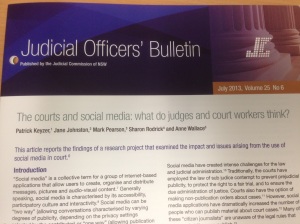By MARK PEARSON Follow @Journlaw
Another article by our collaborative Courts and Social Media research team has been published – this time in the Judicial Officers’ Bulletin (Published by the Judicial Commission of NSW).
A hearty thanks to my colleagues – Patrick, Jane, Sharon and Anne – for your collaboration! It is a team of academics from four universities – Bond, Griffith, Monash and Edith Cowan – proving that worthwhile research can defy institutional and geographic boundaries.
The citation is:
Keyzer, P., Johnston, J., Pearson, M., Rodrick, S. and Wallace, A. (2013). ‘The courts and social media: what do judges and court workers think?’ Judicial Officers’ Bulletin, 25 (6). July 2013: 47-51.
 The full pdf of the article can be viewed here at the site of the Centre for Law, Governance and Public Policy at Bond University, but here is the introduction to give you a taste for it:
The full pdf of the article can be viewed here at the site of the Centre for Law, Governance and Public Policy at Bond University, but here is the introduction to give you a taste for it:
“Social media” is a collective term for a group of internet-based applications that allow users to create, organise and distribute messages, pictures and audio-visual content.[1] Generally speaking, social media is characterised by its accessibility, participatory culture and interactivity.[2] Social media can be “two way” (allowing conversations characterised by varying degrees of publicity, depending on the privacy settings selected by the contributor) or “one way” (allowing publication of information, but not permitting comment).[3]
Social media have created intense challenges for the law and judicial administration.[4] Traditionally, the courts have employed the law of sub judice contempt to prevent prejudicial publicity, to protect the right to a fair trial, and to ensure the due administration of justice. Courts also have the option of making non-publication orders about cases.[5] However, social media applications have dramatically increased the number of people who can publish material about court cases.[6] Many of these “citizen journalists” are unaware of the legal rules that restrict what they can publish.[7]
At the same time, social media have created unprecedented opportunities for the courts to engage with journalists and the wider community.[8]
This article reports on the findings of a small research project conducted in February 2013 with 62 judges, magistrates, tribunal members, court workers, court public information officers and academics working in the field of judicial administration. We acknowledge that there were no journalists present, and our findings therefore are skewed towards the legal profession. However, so far as we are aware, this is the first attempt to gauge the opinions of some key stakeholders on the issues in this area. We intend to follow up this pilot project with more research to build on our findings.
After describing our research methodology, we outline the findings and offer our brief reflections.
[1] T Bathurst, “Social media: The end of civilisation?” The Warrane Lecture, 21 November 2012, UNSW, Sydney, p 7; A Kaplan and M Haenlein, “Users of the world, unite! The challenges and opportunities of social media” (2010) 53(1) Business Horizons 61.
[2] P Keyzer, J Johnston, G Holland, M Pearson, S Rodrick and A Wallace, Juries and Social Media, Centre for Law, Governance and Public Policy, a report commissioned by the Victorian Department of Justice on behalf of the Standing Council on Law and Justice, 16 April 2013, [1.2], <www.sclj.gov.au/agdbasev7wr/sclj/documents/pdf/juries%20and%20social%20media%20-%20final.pdf> accessed 20 June 2013.
[3] Privacy Victoria, “Social Networking”, Information Sheet 04.11, September 2011, at <www.privacy.vic.gov.au/domino/privacyvic/web2.nsf/files/social-networking/$file/info_sheet_04_11.pdf> accessed 20 June 2013.
[4] For a discussion of these challenges, see: M Pearson, Blogging and Tweeting Without Getting Sued, Allen and Unwin, Sydney, 2012; P Keyzer, J Johnston and M Pearson, (eds), The Courts and the Media: Challenges in the Era of Digital and Social Media, Halstead Press, Sydney, 2012.
[5] D Butler and S Rodrick, Australian Media Law, 4th edn, Thomson Reuters, Australia, 2011, ch 6. There is also an increasing tendency of courts to make general non-publication orders rather than rely on people knowing and complying with the common law of sub judice contempt. In other words, courts are prohibiting by specific order what would be prohibited by contempt laws anyway.
[6] Juries and Social Media, above, n 7, at [2.3].
[7] ibid.
[8] J Johnston, “Courts’ New Visibility 2.0”, in Keyzer, Johnston and Pearson, (eds), The Courts and the Media: Challenges in the Era of Digital and Social Media, above, n 9.
…
Disclaimer: While I write about media law and ethics, nothing here should be construed as legal advice. I am an academic, not a lawyer. My only advice is that you consult a lawyer before taking any legal risks.






